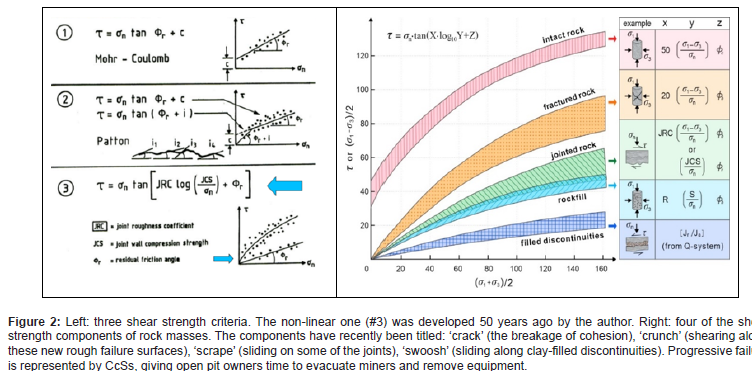 Mini Review Article
Mini Review Article
Numerical Modelling Trends in Tunnelling and Rock Slope Stability: Current Concerns of Some of us
Nick Barton, Nick Barton & Associates, Oslo, Norway
Received Date: January 06, 2023; Published Date:January 24, 2023
Mini Review
In recent keynote lectures the author of this brief ‘opinion piece’ has utilized variants of the title: ‘Continuum or Discontinuum’ – adding ‘that is the question’ and also ‘GSI or JRC’? The reason for such titles is the last 20 years or so of numerical modelling practice for tunnel design and rock slope stability checks. These have seemingly been dominated by the marketing success of the rock mass classification method GSI – the so-called ‘geological strength index’, and the complex set of equations also proposed by Hoek and Brown and co-authors which we can abbreviate to ‘H-B’. Both are utilized in Rocscience finite element models such as Phase 2 or RS 2. The simple-to-use software this company has developed which is needed to utilize the page-wide H-B equations has caught the attention of the younger generation, who can quickly obtain colourful plots of stress distributions and so-called ‘plastic zones’ surrounding supposedly over-stressed tunnel excavations. In the area of rock slope and open-pit stability the same methods (GSI, H-B, RS 2 or other FEM methods) can rapidly provide ‘spoon-shaped’ and colourful failure predictions, as if a slope in jointed rock is suddenly bereft of its geologic structure and ‘fails’ as if it was a slope in a ‘continuous’ isotropic medium like soil or rockfill. Both the above: ‘plastic zones’ and ‘spoon-shaped’ failures can be questioned for their link to real behaviour Figure 1 shows one realistic and one unrealistic simulation.

Some years ago, a formal court case proved that the combination of GSI and H-B and a finite element continuum model produced predictions of ‘plastic zone’ tunnel distress that had no relation to the stability of the almost unlined pressure tunnel in question. Some of its invert had been damaged by much too fast tunnel emptying. It was not in a ‘plastic’ state of over-stress before the dewatering, as claimed ‘by the other side’. We find in fact that a big portion of the lack of realism of numerical modelling of tunnels and slopes is caused by the ‘classic’ addition of the cohesive and frictional strength components (the Mohr-Coulomb M-C model) as illustrated in Figure 2 (Left). This method is conveniently used to describe the shear strength of rock joints: c + σn tan φ, based on the assumption of linearity and a cohesive ‘intercept’. In the case of it’s non-linear ‘improvement’ by the H-B equations for ‘c’ and ‘φ’ as used in continuum modelling, the complex equations are reproduced in Table 1 to emphasise their ‘page-wide’ nature. In reality ‘c’ is broken before ‘φ’ is fully mobilized.
Table 1:The reader may understand why there is concern in the profession. Due to the smaller supporting equations, the so-called ‘geologic strength index’ GSI appears sixteen times in the H-B equation for ‘c’ and twelve times in the H-B equation for ‘φ’. Yet GSI is itself the subject of numerous attempts at improvement as it is recognized as difficult to quantify. Furthermore, a disturbance factor D (0 to 1) allows almost any value to be obtained. Two related complex equations for deformation modulus can acquire almost any desired value due to D, and also have no adjustment for depth. This is incorrect. We have major reasons for misgivings about continuum modelling in rock engineering.

Possibly more than 90% of our tunnels and caverns and rock slopes suffer stress redistribution and deformation, often of only millimeters magnitude, due to the influence of jointing, and sometimes faulting. If tunnels should be under-supported or rock slopes excavated too steep, the failure process is likely to be progressive. Increased deformation can be monitored, and mitigation measures installed.

We have major reasons to hope that the profession of rock engineering uses numerical modelling with better links to reality in the future. A discontinuum approach undoubtedly helps since we are dealing with a mostly discontinuous medium [1].
Acknowledgment
None.
Conflict of Interest
No conflict of interest.
References
-
li>Barton N (2022) Keynote Lecture. Continuum or Discontinuum – that is the Question. IXth Latin America Rock Mechanics Symposium. ISRM, Asuncion, Paraguay.p.26.
-
Nick Barton*. Numerical Modelling Trends in Tunnelling and Rock Slope Stability: Current Concerns of Some of us. Cur Trends Civil & Struct Eng. 9(4): 2023. CTCSE.MS.ID.000717.
-
Building, Environment, Curtainwall, Earthquake, Structural engineer, Geometric
-

This work is licensed under a Creative Commons Attribution-NonCommercial 4.0 International License.






